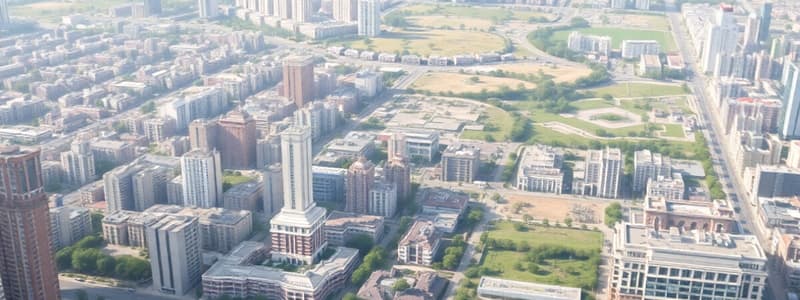Podcast
Questions and Answers
Which urban function is primarily associated with the exchange of goods and services?
Which urban function is primarily associated with the exchange of goods and services?
- Industrial function
- Retail function (correct)
- Commercial function
- Educational function
What key factor assists in determining land value in urban planning?
What key factor assists in determining land value in urban planning?
- Population density
- Proximity to educational institutions
- Neighborhood demographics
- Site and internal situation (correct)
How does bid rent influence urban land use?
How does bid rent influence urban land use?
- It restricts residential areas to low-density developments.
- It determines the maximum price that any buyer is willing to pay for a piece of land. (correct)
- It prioritizes retail functions in suburban areas over central locations.
- It increases the intensity of industrial land use.
What is the prime-value intersection (PVI) primarily characterized by?
What is the prime-value intersection (PVI) primarily characterized by?
Which statement best describes the relationship between land value and urban function distribution?
Which statement best describes the relationship between land value and urban function distribution?
What factor is primarily responsible for increased land value in Central Business Districts (CBDs)?
What factor is primarily responsible for increased land value in Central Business Districts (CBDs)?
Which statement best describes the relationship between residential areas and their distance from the CBD?
Which statement best describes the relationship between residential areas and their distance from the CBD?
What effect did the horse car and electric street car era have on urban development?
What effect did the horse car and electric street car era have on urban development?
Which of the following is NOT a role typically associated with a CBD?
Which of the following is NOT a role typically associated with a CBD?
What are the primary externalities experienced by households living near a CBD?
What are the primary externalities experienced by households living near a CBD?
Flashcards are hidden until you start studying
Study Notes
Urban Functions and Land Use
- The distribution of urban functions is driven by market forces, specifically through the concepts of land value and bid rent.
- Land value determines the cost of land and how it is used.
- Urban functions are classified as:
- Retail: Exchange of goods and services (e.g., Shopping districts and malls)
- Industrial: Manufacturing of goods (e.g., Industrial areas with factories and warehouses)
- Commercial: Offices, business services, financial services etc.
- Residential: Residential areas, inner-city vs suburban
- Public Space and Recreation: Areas for public interaction and leisure
- Educational: Universities, schools, and other educational institutions.
Land Value and Bid Rent
- Land-use is determined by land-value, with higher-valued land used differently to cheaper land.
- Land-value also impacts the intensity of land-use.
- Bid rent is the amount of money a particular parcel of land could expect to receive and is greatly influenced by site and internal situation.
- Site refers to the physical attributes of the location, such as access to resources, views, and terrain (e.g., factories need flat land, while most people prefer hilly areas with views).
- Internal Situation refers to the location compared to other parts of the city, including accessibility and proximity to other features.
- Prime-value intersection (PVI) is a point in the city with the greatest access and highest land value, historically the CBD. It serves as a reference point for determining other land values based on distance and access.
- Land value decreases with increasing distance from PVI, directly impacted by transportation access.
- Higher land value in PVI leads to greater intensity of land use (e.g., skyscrapers).
The Central Business District (CBD)
-
It is a distinctive feature of many cities, historically important for its centrality and functional concentration.
-
While its importance has decreased due to decentralisation and decline, it still plays a crucial role in many cities.
-
The CBD's centrality attracts transportation breaks (break-of-bulk-points) and has a combination of roles including:
- Central marketplace
- Entertainment and cultural services
- Major transportation node
- Administrative centre
- Corporate offices
-
The CBD is characterized by high land value, intensive land-use, high density, pedestrian traffic, and traditionally lower residential population.
Residential Users
- Residential intensity decreases as you move away from the CBD: apartments > semi-detached > detached single-family homes.
- In many US and South African cities, wealthier households tend to live in suburban and exurban areas, while poorer households live closer to the CBD. This is driven by: - Larger residential homes and escaping negative externalities like noise and pollution in suburban areas. - The proportionate cost of access is higher for the poor than the wealthy.
- There are also positive externalities associated with living closer to the CBD, such as access to retail, entertainment, and cultural amenities.
- Urban density gradient, with differing night-time and day-time densities, is notable.
Urban Transportation and Changes in Land-Value
- The concept of land value and bid rent is closely linked to the expansion of cities.
- Transportation provides access, directly impacting land value.
- The evolution of transportation systems has changed the urban landscape:
- The Walking City (pre-1850):
- Functional integration (mixed-use neighbourhoods)
- Retail scattered throughout residential areas.
- Social integration
- Absence of a distinct CBD
- Horse Car and Electric Street Car Era (1850-1920): - Urban expansion - Social class division. - Emergence of the CBD. - Increased mobility.
Studying That Suits You
Use AI to generate personalized quizzes and flashcards to suit your learning preferences.




